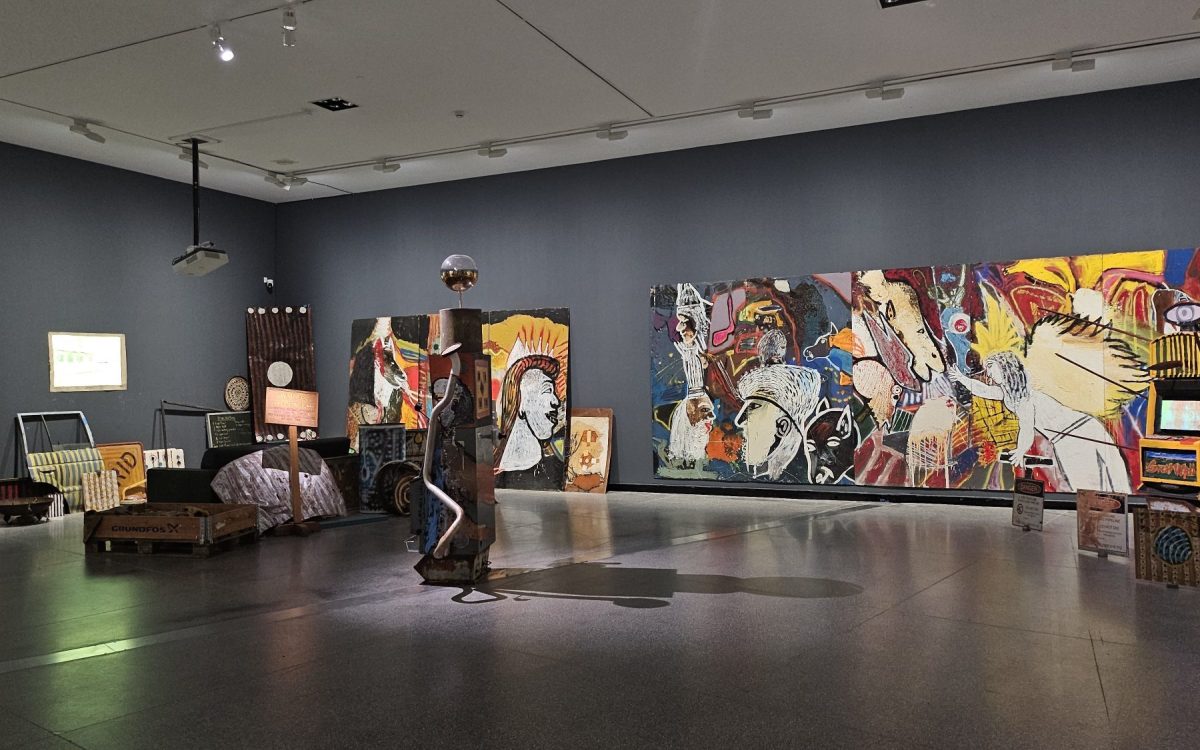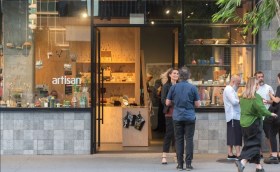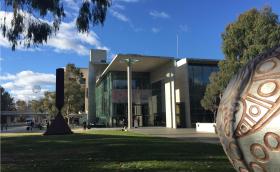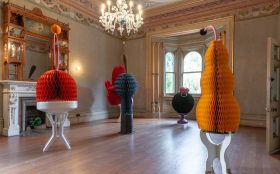‘Juparnta Ngattu’, ‘Minjinypa’, ‘Iconocrisis’, ‘ceremonial strength and power through image-making’, ‘cheeky one or trouble(maker)’, ‘icono-crisis’ – so much of Tennant Creek Brio’s survey exhibition at the Australian Centre of Contemporary Art (ACCA) is encapsulated in these Warumungu, Warlpiri and English words. With oil barrels, poker machines, ‘found’ mining maps and a wasteland guardian angel, Tennant Creek Brio: Juparnta Ngattu Minjinypa Iconocrisis is imbued with the punk and outlaw spirit of its collective members.
The Brio comprises a more or less fluid collective of artists living and working on Warumungu Country, born out of a men’s art therapy program in 2016. The current show features works by key members Eleanor Jawurlngali Dixon, Fabian Brown Japaljarri, Lindsay Nelson Jakamarra, Rupert Betheras, Joseph Williams Jungarayi, Clifford Thompson Japaljarri, Jimmy Frank Jupurrula, Fabian Rankine Jampijinpa, Gary Sullibhaine, Lévi McLean and Marcus Camphoo Kemarre.
UAP: Unidentified (Ab)original Phenomenon (2024) guards the door to ACCA’s main gallery with a scavenged head of a plastic kangaroo donning deer antlers and two gigantic shell petroleum signs as wings. Voiced by Jungarayi, its presence is simultaneously foreboding and comical, signalling the juxtaposition of corruption and creativity while serving up visual cues for what is to come.
This raw energy carries across to a range of paintings on found material – from car bonnets to solar panels – which fill out the space of gallery one comfortably. Sourced from the decommissioned Warrego mine and reclaimed by The Brio through words and symbols, the pieces are not just stagnant artworks, but an ongoing process of empowered First Nations intervention.
Jakamarra and Betheras’ Solar Reactor series (2024) repurposes discarded and cracked solar panels, an ironic end to the sustainable energy solution. The clean and restrained constellation of solar cells comes into contact with unevenly textured paint in yellow, white and ochre.
A large installation of 30 paintings created between 2018 and 2024 by Brio artists is laid out like a train of thought, encompassing history, self-representation and symbols of Country. There are moments of chaos and an almost graffiti-like randomness, restrained into tiled squares that seem to merge with the architecture.
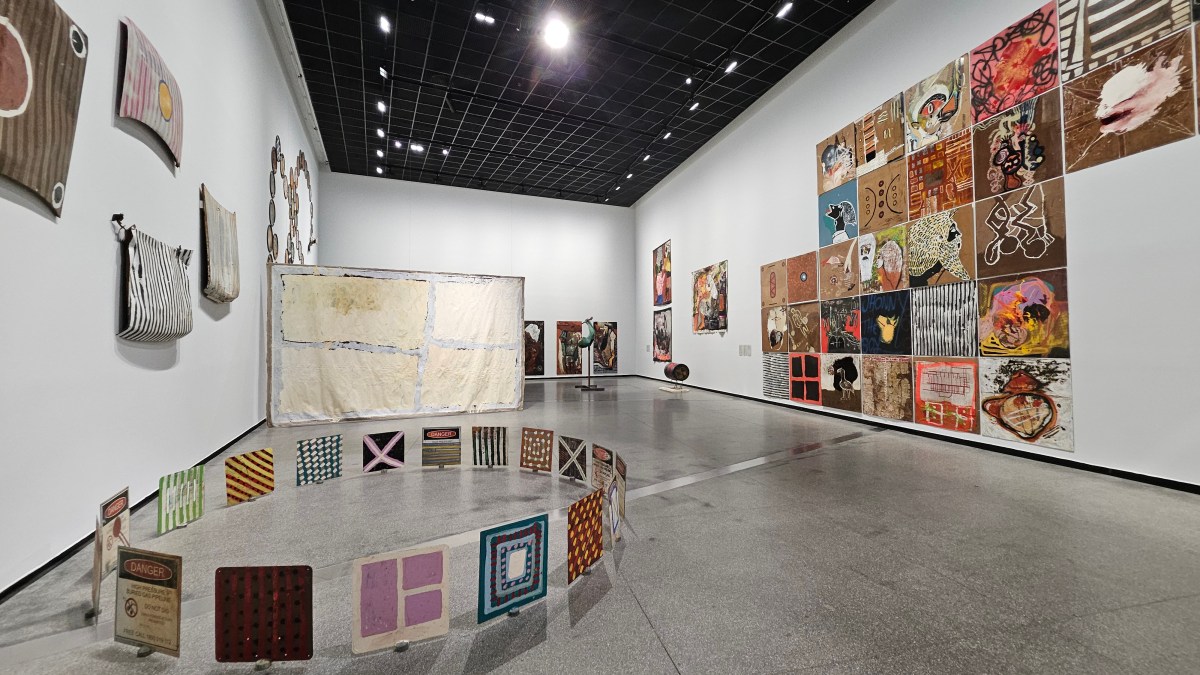
Visitors are invited to step inside the Brio’s studio as the next gallery recreates parts of the collective’s creative hub on the outskirts of Tennant Creek with a video that captures members at work and a sofa that seems to envelop you when you sit down. Three poker machine assemblages are satires on post-apocalyptic greed, contrasted against a painting by Fabian Brown Japaljarri and Betheras of a red-haired mum with a sly expression and the speech bubble “Bugger off! or I’ll Shoot This Is Me and My Unborns Money Safe”. The room plays on the tension between comfort and despair, and brings back to mind the mantra of the show’s title.
This tension is matched in the curatorial, with contributions from outgoing Artistic Director and CEO Max Delany, Yalingwa Curator Dr Jessica Clark, Elyse Goldfinch, Dr Shelley McSpedden and Curatorial Adviser Dr Erica Izett. The exhibition is packed, but it never reaches the tipping point of overwhelming or overloading its visitors.
The thrumming soundtrack and disorder in the studio is cast aside as a horizon of paintings enter your field of vision, lined in single file across walls painted in the soft shade of green apple sorbet. Clark mentions that the colour brings another piece of Tennant Creek back to the gallery – it’s the green of sun-bleached corrugated iron. Eleanor Jawuringali Dixon’s soundscape Cosmic Mother matches the celestial wonder of Jimmy Frank Jupurrula’s mystic orb that reflects its surroundings.
It’s a welcome mental and visual ‘break’ before entering into the deep end of the final gallery where wall-to-ceiling mining maps filled with expressive interventions almost cave in on the viewer, demanding head-on acknowledgement of the wrongs suffered by Country and community. In one corner, the red pigment seeps through the maps, appearing blood-soaked.
Read: Exhibition review: Bandarr Wirrpanda and Yinimala Gumana: Timeless, MAGMA Galleries
In Juparnta Ngattu Minjinypa Iconocrisis, every room offers something different, bound by the relentless energy and generosity that the Brio has chosen to share with its visitors. There’s no doubt that as the first survey exhibition of the collective, ACCA has put on a landmark show exemplifying the prowess of contemporary First Nations narratives that come from outside the urban vicinity.
Tennant Creek Brio: Juparnta Ngattu Minjinypa Iconocrisis is on view at ACCA from 21 Septeber to 17 November; free.

